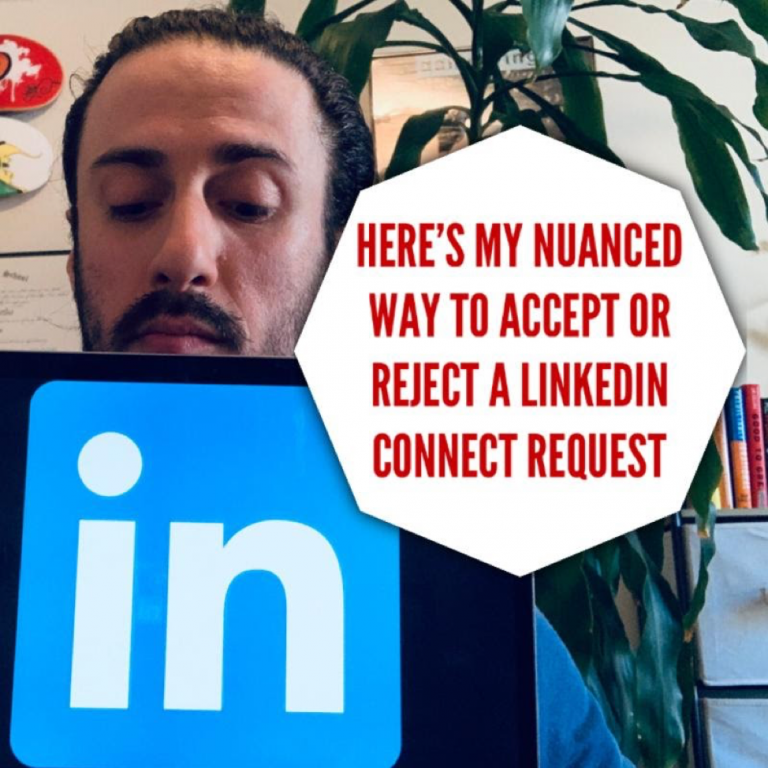Earlier this week, I wrote about the basic criteria I use when I deny LinkedIn requests and I got lots of interesting, thoughtful feedback from folks on LinkedIn about how they accept or reject requests. Obviously, as with all things, there’s a lot of grey area when it comes to deciding when to deny LinkedIn requests or accept them.
Today, I’m sharing my more “nuanced” rejection criteria when I’m on the fence about rejecting or accepting a request. What do you think they are? Take a look below!
Why I have a nuanced process when I deny LinkedIn requests
First, what I mean by an “on the fence” LinkedIn request is that despite meeting certain criteria that I mentioned in my last post, the person isn’t an “obvious” LinkedIn rejection. For example, if a request comes from someone working in a different industry but they post about marketing/branding for their industry rather than general advice, I will accept the request. Because, as many folks have pointed out, it’s important to connect with individuals in other industries. Connecting with people in other industries can be a gift because you can learn from them and collaborate on upcoming projects.
The opposite happens, too. Sometimes even when a person’s profile isn’t immediately a turn-off or seems like a good fit for your LinkedIn network, they may end up spamming you and crowding your LinkedIn experience.
If you didn’t read the last blog post, my previous criteria (generally) when I deny LinkedIn requests included:
- Profiles with under 100 followers (be ware of fake profiles with just a few followers)
- People that are recruit outsourced IT positions (they almost always try to sell me on hiring one of their candidates)
- People that are do business development (they almost invariably sell me immediately after connecting)
- People in unrelated industries (not always, but I’ve found that people in totally unrelated industries who don’t engage or share content are likely just hoarding followers).
So now that you know my basic criteria, we can move on to the more complicated ones. I’ve already discussed the value of having a network that includes other industries but here are the three additional criteria I consider when it comes to LinkedIn requests:
When I deny LinkedIn requests: Our mutual connections
Like I said in the last post, I check for a lack of mutual connections. When none of our mutual connections are people I know personally, that’s a red flag. It means they probably requested my mutual connections and my profile at the same time during a spree rather than an actual connection.
When I deny LinkedIn requests: Their recent activity on LinkedIn
This is a big one for me. When I get a request, I’ll go into their recent activity to see what kind of content they are posting. Another thing I’ll check is how often they are posting. If they are posting 25 times a day or if the content has no theme/value, I pass. No one needs another person on LinkedIn who isn’t providing something of value- especially if they are spamming content out every day. If they are posting content I will never engage with then what’s the point? It’s better not to waste your time.
When I deny LinkedIn requests: Their follower count
In my last post I mentioned profiles that have less than 100 followers, but this is about profiles with the opposite: thousands and thousands of followers. Of course, I’m not rejecting requests from profiles having under 100 followers or a lot followers based on just this one criteria. If the person shares a ton of content that has no value to me and our mutual connections aren’t people I know, AND if they have tons of followers (anecdotally ~6K – 15K), that means that they’ll connect with anyone…No thank you!
When I deny LinkedIn requests: How I handle my requests in real-time
While I was writing this post, I got 4 new LinkedIn requests:
- I really like that this person added a note, told me what they do, made an offer, and asked a question. I don’t need their services so I rejected them to save us the trouble. But this was a great cold request.
- This request sounded flattering. Their message said that I was selected to appear in a top attorneys magazine, but someone already reached out before, and when I asked them why they chose me since I don’t practice anymore, and they never replied. Now someone new sent the same message, so this is spam. PASS!
- This person’s description’s “claims” left me confused, but our mutual contacts were people I actually knew so I clicked on their profile, realized that we went to the same school, and accepted them happily!
- This person is clearly an attorney, we shared a lot of mutual contacts and they’re in my field, so even though there was no note, I accepted!
I wanted to share this to show you how I go about deciding to approve or deny LinkedIn requests. To me, adding a note is HUGE, even though some people think they’re a waste.
These are my more nuanced “rejection criteria.” Have these blog posts changed how you accept or deny LinkedIn requests? Do you have your own way of vetting Linkedin requests? I’d love to know! Share your experience below.



